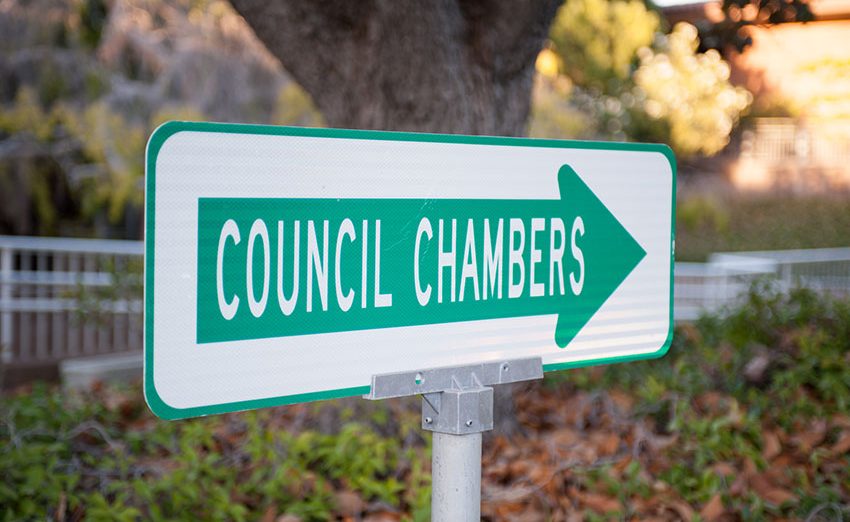The Santa Clara City Council has agreed to amend the Gateway Crossings project after the developer said the economic downturn caused by coronavirus has made early construction of a 225-room hotel no longer feasible.
The 24.2-acre mixed use development, located at 1205 Coleman Ave. near the Caltrain station, has been the topic of much controversy since its inception. However, last year, after additional public outreach and renegotiating with developer Hunter Storm Properties, the Council unanimously approved construction at the site.
Part of the agreement required Hunter Storm to build the hotel during the first of two phases but relaxed affordable housing requirements — 10 percent instead of the City’s usual 15 percent. After Tuesday’s decision, much of the work set to be done during Phase 2 will now be done earlier, including construction on two of the three residential buildings, amounting to 725 apartments.
A reserved space for the Police Activities League and 11,200 square feet of retail originally slated for the second phase will now be part of Phase 1.
Deke Hunter, President of Hunter Storm, said he was willing to increase the affordable threshold as a way to “show that we are working with the community.” Still, he was firm in saying that COVID-19 has hit the hospitality industry too hard to make building the hotel first viable.
Council Member Debi Davis said she found herself “between a rock and a hard place” since the development brings so much to the City, but she said she worried the precedent altering the development agreement would set.
Mayor Lisa Gillmor said the amendment made sense since it is obvious the pandemic has “decimated” the hotel industry.
“We thought we put everything to bed, but we didn’t,” she said. “The pandemic hit. The pandemic is nobody’s fault … it has become a tremendous burden.”
Just as before, many members of the public commented on the project, giving mixed opinions. While nobody outright opposed the development, many said the City should push harder for additional affordable housing, a request that was eventually granted.
The Council approved amending the development agreement unanimously.
Briarwood Drive To Get Speed Humps
The Council also broke from convention when it opted to install traffic calming measures along Briarwood Drive between Cabrillo and Warburton Avenues.
In January, a petition with 62 signatures calling for the installation of speed humps came before the Council. That petition claimed that the frequent speeding, noise, property damage and traffic collisions were disproportionate to a typical residential neighborhood, affecting its residents’ quality of life.
Micheal Liw, Assistant Director of Public Works, told the Council that when City employees studied the street, which runs 2,100 feet, the data did not meet the threshold typically established in the Neighborhood Traffic Calming Program. That program has three levels of response, with street alterations such as speed humps or roundabouts, being the highest level.
Typically, Liw said, for a residential street with a speed limit of 25 mph, the week-long study would have to show an average speed along the street higher than 33 mph. While the data skims that threshold, the average speed was just shy. Further, he said, typically the public works department would have support of every resident within 100 feet of the proposed speed hump, something Liw said has yet to be met.
One of the residents, Ibrahim Avci, noted how, although the average speed did not exceed 33 mph, one vehicle in the study was clocked at 80 mph.
“Excessive speed is the main issue. We would like you guys to address that so we can have a safe space,” he said.
A couple people suggested narrowing the street’s lanes as an alternative. Still, the Council supported installing the speed humps.
Gillmor called the situation “outrageous,” saying motorists often use the street as a “cut-through” instead of driving on Lawrence Expressway.
Council Member Kathy Watanabe said the issue has been delayed long enough.
“They want this. They have been dealing with this for a long time. It is time we listen to the residents,” she said. “The residents spoke. They have spoken more than one time. We need to address their concerns.”
Consent Calendar Spending
In addition to approving a water and sewer rate assistance program in the wake of the COVID pandemic, the Council approved the following spending via the consent calendar:
- A 5-year, $4.54 million contract with Golder Associates Inc. for the operation maintenance and monitoring of the landfill for the Related Santa Clara Project ($400,000 of this money is developer contributed.)
- An $87,742 increase to a contract with Housing Trust Silicon Valley for administration services for the Below-Market Purchase Program; the not-to-exceed amount is set at $452,592.
- A $228,835 contract with McCampbell Analytical, Inc. for “general chemistry laboratory services.”
- A $3 million contract with Stantec Consulting Services, Inc. and Bellecci & Associates for underground electrical distribution system design services; this contract also empowers City Manager Deanna Santana to “add or delete services consistent with the scope of the agreements and allow future rate adjustments.”
The Council meets again Tuesday, July 14 in the Council Chambers at City Hall, 1500 Warburton Ave. in Santa Clara.
Members of the public can participate in the City Council meetings on Zoom at https://santaclaraca.zoom.us/j/99706759306; Meeting ID: 997-0675-9306 or call 1(669) 900-6833, via the City’s eComment (available during the meeting) or by email to PublicComment@santaclaraca.gov
For those without the above access, the City cafeteria has been set up to accommodate up to 10 people at a time and public comment will be given from that location.






